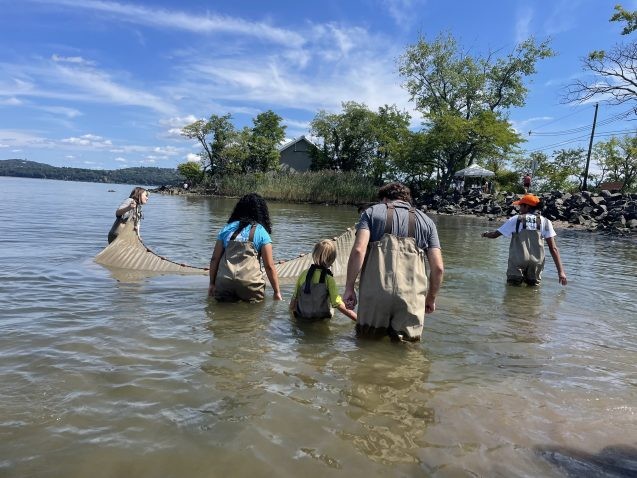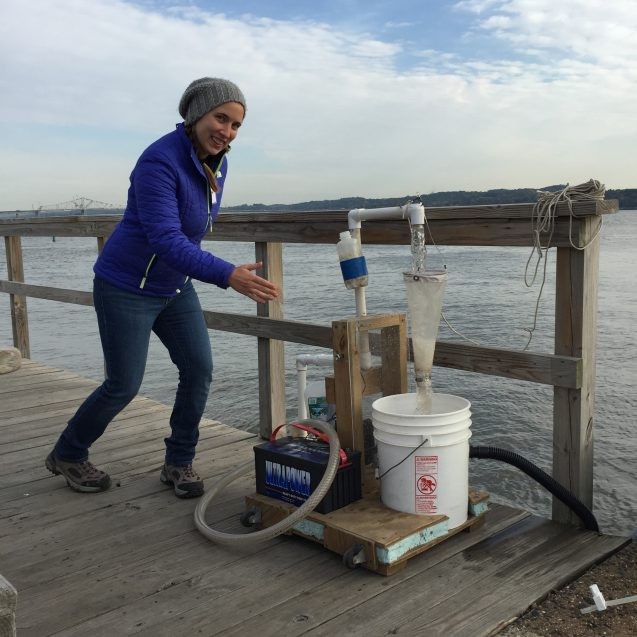A Summer of Science Saturdays: Casting a Wide Net at Lamont
Columbia’s Lamont-Doherty Earth Observatory’s community education program draws in students of all ages to learn about the Hudson River.
Every Saturday, from the beginning of July through Labor Day weekend, at the tip of the Piermont Pier, a small cohort of Lamont-Doherty Earth Observatory science communicators set up their gear, which — among other tools — includes a seining net and a collection of differently sized waders. It is an invitation to the greater community of the science-curious and passersby to suit up and step into the wild wonder that is the Hudson River.

“We believe that science is best taught outdoors in the natural environment,” says Margie Turrin, director of educational field programs at Columbia Climate School’s Lamont-Doherty Earth Observatory. By teaching outdoors, Turrin means taking participants, who range in age from young children to mature adults, right into the Hudson. Foundational to the program is immersion, and a primary activity during the sessions is “seining the river.”
Seines are long nets connected to two long poles. One end is attached to the shore and the other end is taken out into the water and circled back around to shore, trapping the fish that are surrounded by the net. Participants get to pull the nets through the river and then examine the creatures they catch.
“We actually teach them how to identify our different fish species and crab species. We also have a variety of other educational material,” said Marisa Lynn Annunziato, Lamont’s education program assistant.
In addition to seining and identifying fish, the sessions — which run from 11 am to 3 pm — focus on rod and reel fishing clinics, water quality testing, and plankton pumping (a practice that involves a rudimentary pump to draw plankton from the river), as well as microbiology identification.
Science Saturdays, which began with a “soft launch” in 2019, were designed to engage the surrounding Rockland County communities (Lamont is in Palisades, New York) and to introduce the public to Lamont’s Hudson River Field Station, located at the end of Piermont Pier. It was once a supply station for Lamont’s research vessels and housed instruments for monitoring local river chemistry and water quality. The structure was heavily damaged in Superstorm Sandy in 2012. The renovated space — which officially reopened to the public in October 2019 — is now a working research facility and base of operations for community education programing.
“Prior to running these events, we had not had any regular engagement with the public on the pier and we wanted to let them know about both Lamont and the Field Station. The Field Station itself is a wonderful resource, but people need to know we are there. Science Saturdays provide a fun and visible mechanism for that,” explained Turrin.
They also wanted to leverage the program to engage young people in science through fun field experiences and improve people’s connection to the Hudson River, Turrin said. The more people understand the character of the river and its creatures, the more invested they are in protecting it.

“An unexpected benefit is that we are building our own understanding of what we might find in our part of the Hudson, how different fish use the Hudson at different stages of their growth, and how differences in precipitation between years affects what we find in our section of the Hudson,” said Turin.
By all measures, organizers say the program has been a success, attracting a dedicated audience of returning participants as well as new enthusiasts.
“[The Pier] is a beautiful place to walk and people happen upon us, and they think what we’re doing is really cool and they want to jump into the river and get to experience it. So, some people are coming because they’ve heard about it. Some people just happen to be there and are interested in the event. You don’t have to register. You’re free to come and go as you please,” said Annunziato. “We tend to have anywhere upwards of 100 plus people coming throughout our timeframe.”
“People always have questions about the Hudson,” said Turrin, “and whether they themselves join us in the water to seine or they just stop by to talk with us, they are always happy to see us there and almost everyone notes they have learned something in the time they spent with us. That is a win!”
